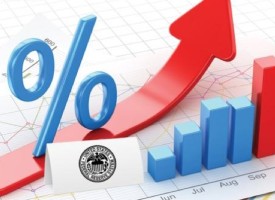Wells Fargo and the repo markets are screaming a liquidity crisis is about to unfold!
Wells Fargo and the Repo Markets: Screaming Signs of a Liquidity Crisis
July 13 (King World News) – Matthew Piepenburg at Matterhorn Asset Management (based in Switzerland): Every market crisis ultimately boils down to a liquidity crisis, namely: Not enough fiat dollars to keep the financial wheels sufficiently greased.
Below, we look at two warning signs from Wells Fargo and the reverse repo market which warn of precisely that: a liquidity crisis.
From Debt Binge to Credit Crunch: A Chronicle of Excess
In a world in which consumers, corporations, and sovereigns have confused (falsely-signaled) debt-based growth as actual growth, a liquidity crisis (bubble to burst) is not a theoretical debate, but a mathematical certainty.
For years, self-serving politico’s, central bankers, Wall Street sell-siders, and a woefully unsophisticated cadre of main stream financial “journalists” have endeavored to downplay this rise-and-“pop” certainty by deliberately ignoring the $280T debt elephant in the global living room.
Of course, that debt, for years, has been “monetized” by increasingly debased currencies and rising money supplies created literally out of nowhere—i.e., from central bank mouse-clicks rather than productivity, evidenced by the embarrassing fact that global GDP is less than 1/3 of the global debt.
Needless to say, money (i.e., “liquidity”) created out of thin air, and then justified with even thinner (yet comfortably titled) policies like Modern Monetary Theory has its temporary charms.
It Was the Best of Times…
Risk assets—namely stocks, bonds and real estate– love easy money, be it printed out of nowhere or lent at rock-bottom (and artificially repressed) interest rates.
For years, the big boy corporations on the major exchanges have been borrowing trillions per annum to buy their own stocks and/or pay dividends, which naturally makes stocks go up rather than down.
In short, when money is flowing, risk assets rise on a rising tide, even if that tide is artificial, “printed,” pretended or extended (yet ultimately a source of financial drowning).
It Was the Worst of Times…
In the meantime, those good-time rising tides benefit an increasingly smaller segment of the social-contract, which explains why historical levels of wealth inequality have led to equally inevitable (and rising) tides of social unrest.
Economics Matters—History Turns on “Dimes”
Despite the fact that such appalling debt dangers existed long before COVID, the “experts” now conveniently blame our fractured societies (and growing debt burdens) on a pandemic while distracting the masses with a media that is far more obsessed with transgender bathroom rights, racial headlines, the latest COVID variant and the sorrows of Prince Harry than they are with the fact that our financial system is rotting right below our feet.
This financial rotting has real consequences for society not just market analysis.
After all, social unrest always follows financial unrest (and inequality), despite the perpetrators’ best efforts to shield themselves from blame…
Listen to the greatest Egon von Greyerz audio interview ever
by CLICKING HERE OR ON THE IMAGE BELOW.
Transparency Matters—But It’s Gone
Of course, as every magician (or covert operative) knows, the best way to pull off a trick is to distract the audience from the real slight-of-hand, allowing the hocus-pocus of a self-inflicted financial disaster to hide from immediate view via lies of omission rather than the courage of accountability.
Perhaps the greatest of these lies was the daily-telegraphed message that extreme money printing and debt expansion was only “temporary” and “under control” as opposed to a full-out addiction which always ends in a fatal financial overdose.
For years, we’ve been told that $28T in global central bank money printing was not inflationary, and finally, when that inflation did rear its head, we’re now being told it’s only “transitory.”
Most, however, know better.
Swapping One Addiction for Another
Frankly, even the central bankers themselves (from Yellen to Powell) are finding it harder to whistle past (or double-speak through) the graveyard of debt and dying dollars which they alone created through appalling balance sheet expansion (addiction) like this:
There is even talk of central bank “tapering,” as these bankers run out of excuses, credibility and options to justify more money printing.
But if one addiction loses its source, there’s always a new drug pusher (and “liquidity” source) to step up, and in a global financial system marked by an addiction to easy money (rather than needed austerity or actual productivity), the newest addiction to replace Fed money printing is now government deficit spending.
That is, extreme fiscal policy is gradually replacing (or at least joining) extreme monetary policy to keep dollars flowing and hence a slowly tanking financial system momentarily “greased” with yet another deadly liquidity “fix.”
Just like we saw QE 1 fatally morph from QE2-4 into “Unlimited QE,” we shall soon see fiscal policy 1 morph into unlimited “fiscal policy” at a nation-state near you; beginning, of course, with Biden et al.
But as we’ve said many times elsewhere, addiction—be it to monetary stimulus or fiscal stimulus—always ends the same way: One either quits or dies.
Again, even the bankers and a small handful of brain-celled politicos know this, which is why we are starting to see signs of a genuine hangover (i.e., crash) in our artificial yet liquidity-addicted financial system.
As for these flashing warning signs, let’s just consider two recent tremors percolating below our feet: 1) Wells Fargo and 2) the reverse repo market…
New interview from legend Doug Casey discussing gold, silver and
global chaos! To listen click here or on the image below.

1. Wells Fargo Welches in Panic
We’ve made many prior warnings regarding the objective evidence of banking risk in the global financial system, and despite Basel III’s virtue signaling, we also warned that those risks were anything but “transitory.”
In fact, even the big boys in the big banks are getting nervous—as well as ahead of—the credit crunch they see coming after years of benefiting almost exclusively from a credit binge which they themselves engineered.
In short, the liquidity they once relied upon is drying up.
Thinking always of themselves first and clients second, Wells Fargo just announced that they are permanently suspending/closing all personal lines of credit (from $3k to $300K) in the coming weeks.
Yes. That’s kind of a big deal…
Wells Fargo is effectively confessing that they are worried (seriously worried) about inevitable credit/loan defaults on their consumer credit lines for which they charge interest at anywhere from 9% to 21% (and who thought usury was dead?).
Why the sudden change of heart at that oh-so generous bank?
Because Wells Fargo is worried about a crisis ahead—namely a liquidity crisis.
Nor is Wells Fargo alone, even many insider businesses (i.e., publicly-traded fat cats) who benefit from the best loan terms are taking on less debt.
Why?
Because their massive debt exposures have just gotten too big to ignore, and they have no choice but to borrow less rather than more…
ALERT:
Billionaire and mining legend Ross Beaty, Chairman of Pan American Silver, just spoke about what he expects to see in the gold and silver markets and also shared one of his top stock picks in the mining sector CLICK HERE OR ON THE IMAGE BELOW TO HEAR BEATY’S INTERVIEW.

Of course, less borrowing means less lending, and less lending means tightened credit, and tightened credit means a credit crunch (i.e., liquidity crisis), and a credit crunch in a world/market addicted to credit (i.e., debt) means ”uh-oh” for risk assets like stocks, bonds and real estate.
Meanwhile, as Wells Fargo hunkers down for the pain ahead, JP Morgan, one of the smartest insiders in the entire (rigged) banking system, is beginning to carefully hoard and stockpile cash ($500B) and moving more to the safety of short-term bonds.
Why?
Well, they’d like to have some dry-powder when risk assets tank and rates rise, for the best time to buy is when there’s blood in the streets; and the best time to lend is when inflation and rates are rising, not falling.
But more to the point, JP Morgan (like Wells Fargo) sees a liquidity crisis on the horizon…
But what suddenly tipped them off?
Let’s talk about the Reverse Repo market…
2. The Reverse Repo Market—Banks Losing Trust in Each Other
Signals from that esoteric (and hence media-misunderstood) corner of the banking system known as the repo market have been making neon-flashing warning signs.
Traditionally, the reverse repo market is where banks went to borrow from banks, typically offering collateral (US Treasuries) for some short-term liquidity—i.e., money at low rates.
But in September of 2019, those rates spiked dramatically for the simple reason that banks began distrusting each other’s credit risk and collateral. That’s a bad sign.
What is happening now is that the Fed, rather than the commercial banks, are taking a much greater role in back-stopping this increasingly fractured intra-bank repo (credit) market.
And unlike retail clients paying double-digit rates for credit lines, the Fed has lifted the interest (IER) they pay to banks (no shocker there) as banks are parking more money at the Fed where they are exchanging cash for Treasuries in a now unignorable flight to safety.
As a result, the repo market has skyrocketed as banks are parking nearly $1T per day at the Fed, which is 3X the normal operational amount.
This is a screaming sign of counter-party risk among the banks themselves, whose last hope is the Fed, not each other.
And why are the too-big-to-fail banks looking for low-rate handouts and T-bills from these grotesquely bloated (and Fed-supported) repo markets?
Because they see a crash coming and are bracing for the transition from credit addiction to credit crunch—i.e., less “liquidity” to grease the broken wheels of overheated credit system.
Risk Assets Facing Real Risk
What does this mean for the great inflation-deflation debate?
Well, a liquidity crisis is never good for risk assets like stocks, which will see a price decline and hence “deflation;” but don’t confuse that with the real-world notion of inflation—namely rising prices for the things most mortals need to live.
As more banks are swapping T-bills as collateral from the Fed rather than each other for cash, this means massive amounts of money (“liquidity”) is coming out of the system.
The money markets are moving massive amounts of dollars to the Fed, which means bank reserve accounts are moving from the banks to the Fed itself; this, in turn, means less bank reserves and hence less bank lending—i.e., a credit tightening rather than credit binging.
Such reduced “liquidity,” as mentioned above, is a very bad omen for risk asset markets…
Insiders just invested another $56 Million in this 12 million ounce
Canadian gold company! TO FIND OUT WHICH ONE
CLICK HERE OR ON THE IMAGE BELOW.
Gold’s Direction and Meaning
As for gold, when markets tank, gold can follow, but with far less depth and speed. Many tapped out investors are forced to sell safer precious metals to cover risk asset losses, and the pinch to gold is temporary yet real when markets tank.
But as deflation hits the exchange prices, inflation in the price of everything else continues its slow climb north, which gold eventually and consistently follows.
In short, in a crisis, gold ultimately shines brightest as its inherent value is inherently superior to tanking currencies, stocks and other risk assets.
As liquidity dries up in a credit crunch, the trend will be disinflationary, but please remember that disinflation is not deflation; it’s a just slower rate of inflation.
Between 1972 and 74, for example, when risk assets tanked in nominal terms by 50% (“deflationary”), consumer prices had risen by 10% (“inflationary”).
Informed gold investors have known for years that the banking system is deeply flawed and that at some point a monetary collapse far greater than the GFC of 2008 is inevitable, which, by the way, does not mean imminent.
Preparation is Wiser than Timing
But for gold investors (rather than traders/speculators), timing is not the motive, preparation is.
When the monetary system implodes (for which the foregoing warning signs from Wells Fargo to the repo markets are merely the first tremors), gold will be far kinder than currencies and traditional risk assets.
The obvious question today is how much deficit spending (inflationary, by the way) will governments commit to in order to fill the gap of dollars now coming out of the commercial banking system?
Again, we already know that commercial bank lending (and credit availability) is down:
Meanwhile, M2 money supply, compliments of deficit spending, was up 25% in 2020 as governments monetized their debt with, alas, more debt…
As hinted above, are we transitioning from unlimited QE to unlimited deficit spending to “solve” liquidity crunches? Are we coming out of one type of addiction and heading into another?
The sad answer is yes, and again, we all know how addictions end.
In short, what we seeing in the repo market will not be the cause of the next yet inevitable implosion, but is merely a dying canary in financial coal mine:
In short: The markets are handing investors a clear warning signal of a liquidity crisis and hence market crisis.
Who will heed it?…This will link you directly to more fantastic articles from Egon von Greyerz and Matt Piepenburg CLICK HERE.
Also of importance…
Eric King: “Chris, your company is widely recognized as one of the best silver companies in the world. How well is the company positioned going forward?”
Chris Ritchie: Thanks Eric, we do believe that we’re very well positioned at the moment and for the long term. I think some of the weakness we’re seeing now is a misunderstanding of that dreaded Lassonde Curve time within the development cycle. Ironically we have tried to structure the company and the stock itself to perform well as we build. It’s a short construction cycle and we anticipate first pour being in Q2 2022 and we have years of drilling for growth ahead of us.
Fully Funded
I’ve been getting a lot of questions about our balance sheet and whether or not we need more capital. The answer is no. We have over $200m US in cash on the balance sheet plus $90m US of available debt of which we intend to draw at least $60m of that. This compares with our capital needs of $138m as laid out in our feasibility study for the building of our process plant, underground development, our on site camp and the power line. Some people aren’t aware that ~$77m of this spend is in the form of a fixed price contract that we have with Ausenco which means that barring some out of the ordinary change, any over runs are paid for by them.
We have made substantial progress with the remaining components of the spend that we’re responsible for so as each day passes, the amount we’re responsible for shrinks and when thinking about the impact to a 10% or 20% over run is very small relative to our working capital. Again, we wanted to give investors confidence that we could whether a severe financial storm while still encouraging our exploration team to go out and grow.
A Very Different Silver Investment Vehicle
We also wanted to create a very differentiated investment vehicle that would be incredibly appealing to shareholders and potential shareholders. There are very few names with over 50% silver production out there and even less that are 100% precious metals. Our Feasibility Study outlines an all in sustaining cost of less than $7.00 / oz of silver equivalent and a payback period of less than one year if you assume $19 silver and $1500 gold. Combine that with our balance sheet and a team that has done this before, we provide best in class defense.
We also intend to be in production ~7 years after our first drill hole vs an industry average in the 20 year range. We have 15 veins at Las Chispas in our Feasibility Study and 34 veins and counting that are not. This hopefully allows us to have above average growth as well without the dilution. Unfortunately mining is a capital intensive business and we wanted to be as efficient with our capital as possible. Up until the start of construction we were able to add $7 of value to our enterprise value for every $1 spent. Our growth focus now is to find high grade ounces in and around our existing mine plan so that we can potentially improve the first few years of the mine plan.
Up until now, our finding cost per ounce has been near $1. Anything near that cost for new ounces given that the capital for the mine has been raised and accounted for adds significant value that drops to the bottom line. Hopefully we can boost our already very attractive cash flow profile in the early days all the while increasing the time period our exploration team has to continue to grow the project. In a world without much yield, we wanted to create something that was as close to a convertible bond as a mining stock could be at our stage while offering exposure to a vehicle that could perform very well in an inflationary environment. SilverCrest Metals, symbol SIL in Canada and SILV in the US.
***Also just released: Inflation Is Everywhere! CLICK HERE.
***Also just released: One Of The Most Remarkable Silver Charts Of 2021 CLICK HERE.
***To listen to E.B. Tucker discuss the recent panic in the gold sector and what investors should expect next CLICK HERE OR ON THE IMAGE BELOW.
***To listen to Alasdair Macleod discuss the gold and silver markets and you can listen to it by CLICKING HERE OR ON THE IMAGE BELOW.
© 2021 by King World News®. All Rights Reserved. This material may not be published, broadcast, rewritten, or redistributed. However, linking directly to the articles is permitted and encouraged.















